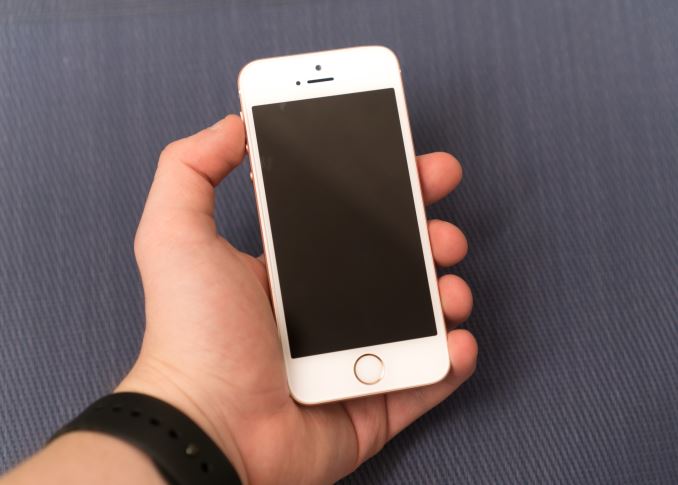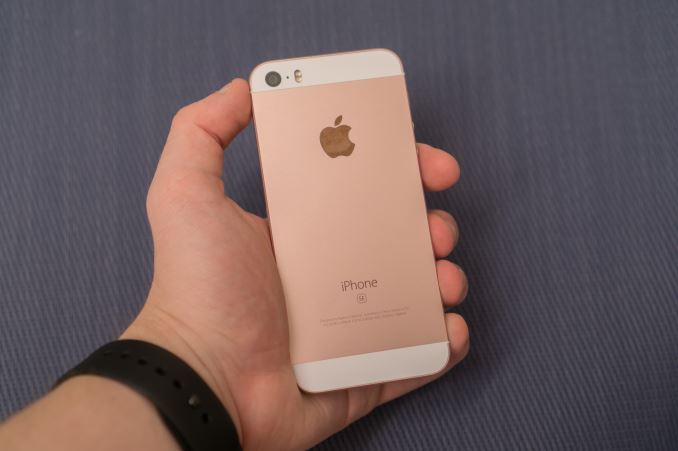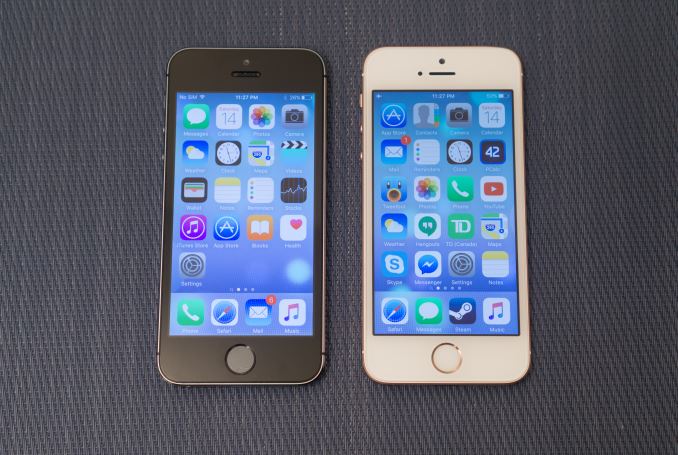The iPhone SE Review
by Brandon Chester on May 16, 2016 8:00 AM EST- Posted in
- Smartphones
- Apple
- Mobile
- iPhone
- iPhone SE

With the launch of the iPhone 6, Apple had finally tapped into the latent demand for bigger iPhones, and as a result we saw some record-setting quarters from Apple. However, at the same time by moving to a larger display size there was a fairly sizeable audience that was being left behind. While a 4.7" phone is generally a one-handed device for most, there's definitely a sizeable portion of iPhone users that bought the iPhone 5s because the 4-inch size was the largest they could go without facing problems with one-handed usability.
The other challenge that Apple faced was their need to be more competitive at the mid-range. For a lot of people, 300-400 USD is pretty much the most that they can afford to pay for a smartphone, and as a result the value proposition for an iPhone flagship that was two generations behind the latest was increasingly weak in markets like India and China, especially when Xiaomi and Huawei were often shipping the latest and greatest hardware for similar prices. While margin might not be as high in this segment of the market, the volume here can definitely compensate.
With these two issues in mind, this brings us to Apple's newest iPhone, the iPhone SE. As Apple's smaller iPhone, the iPhone SE has two functions. It provides a viable option for users who want a smaller iPhone, and it allows Apple to sell at price points that they can't reach with their larger and more expensive iPhones. This is especially key with Apple's push to increase sales in emerging markets like China and India, as for many people the price of the iPhone 6s and 6s Plus makes them inaccessible. As you'll see, the iPhone SE brings the price of a new iPhone lower than it has ever been before.
It's probably no surprise at this point, but the iPhone SE is going to be a familiar phone. With essentially the same chassis as the iPhone 5s, the iPhone SE marks the first time that Apple has used the same design in three generations of an iPhone. While the iPhone SE is the same as the iPhone 5s on the outside, Apple has made some serious improvements to what's on the inside. Below you can see how Apple's new 4-inch smartphone compares to its predecessor, and to Apple's flagship iPhone, the iPhone 6s.
| Apple iPhone Line | |||
| Apple iPhone 5s | Apple iPhone SE | Apple iPhone 6s | |
| SoC | Apple A7 2 x 1.3GHz Apple Cyclone |
Apple A9 2 x 1.85GHz Apple Twister |
|
| GPU | PowerVR GX6450 | PowerVR GT7600 | |
| RAM | 1GB LPDDR3 | 2GB LPDDR4 | |
| Display | 4.0-inch 1136 x 640 IPS LCD |
4.7-inch 1334 x 750 IPS LCD |
|
| Size / Mass | 123.8 x 58.6 x 7.6 mm 112 grams |
123.8 x 58.6 x 7.6 mm 113 grams |
138.3 x 67.1 x 7.1 mm 143 grams |
| Camera | Rear Facing 8MP iSight with 1.5µm pixels + True Tone Flash |
Rear Facing 12MP iSight with 1.22µm pixels + True Tone Flash |
|
| Front Facing 1.2MP f/2.4 |
Front Facing 5MP f/2.2 + Retina Flash | ||
| Storage | 16GB 32GB 64GB |
16GB 64GB |
16GB 64GB 128GB |
| I/O | Apple Lightning connector, 3.5mm headset | ||
| WiFi | 2.4/5GHz Dual Band 1x1 802.11n BT 4.2 |
2.4/5GHz Dual Band 1x1 802.11ac BT 4.2, NFC |
2.4/5GHz Dual Band 2x2 802.11ac BT 4.2, NFC |
| Price | 16GB: $449 | 16GB: $399 64GB: $499 |
16GB: $649 64GB: $749 128GB: $849 |
Even if I hadn’t put any images on this page, it’s likely that you’d be able to visualize the design of the iPhone SE. At its core it’s a design that has been around since 2012, with a few tweaks having been made along the way. Despite that, it’s a design that still holds up, and I think the HTC One M7 is the only other device from that time that you can really say that about today.
From an aesthetic point of view, the chassis style of the iPhone 5, 5s, and SE is still one of my favorite smartphone designs. The flat sides, chamfered edges, circular volume buttons, and antenna inserts all make for an elegant look, and in my opinion it’s actually a more visually appealing design than that of the iPhone 6/6s which uses injected plastic antenna lines, chiclet buttons, and a camera hump. On the flip side, the iPhone 6 definitely comes ahead as far as ergonomics are concerned. The flat sides and chamfered edges of the SE make for an elegant design, but when you make a phone with flat edges on all sides you inevitably end up with a somewhat brick-like device that doesn’t conform well to the human hand. The fact that the iPhones with this design have all had displays of 3.5” or 4” lets them get away with this due to their smaller profile, but there’s no denying that the curved iPhone 6 design has a better in-hand feel.
Almost nothing has changed externally going from the iPhone 5s to the SE. The dimensions are unchanged, and the mass has only gone up by a single gram. I've only noticed two changes. The first is the elimination of the regulatory logos from the rear of the chassis, and the second is a change from a shiny chamfered edge to one with a matte finish that matches the rest of the chassis. Beyond that, and the inclusion of the new rose gold color, the design is unchanged from the iPhone 5s.
Going with an older design has some advantages and drawbacks, and some of these end up being the same aspect viewed from two different perspectives. For example, with the SE being a less expensive iPhone in an older design, Apple isn’t pushed to make it the thinnest possible device. While this is arguably a bad thing by Apple’s own standards, it does mean that there’s more space for the battery than if Apple were to slim down the device, and you don’t get a camera hump. The older design does come with a fairly large bezel on the left and right sides of the screen relative to the size of the display itself, and the black space between the white face plate and the actual screen is significantly thicker than on newer iPhones which does make the design look a bit dated.
The iPhone SE may be part of a larger general trend where smartphone designs don’t change as significantly from generation to generation now that the market is maturing. In many ways, having to change your design every year is actually not a good thing, as it implies that your past design had significant flaws that necessitated a brand new one. Samsung’s Galaxy S7 is a good example of this, with the design changes being minimal but noticeable refinements on the existing Galaxy S6 which had a much better design than its predecessors. Good design is long-lasting, and much like how the truly good laptops on the market can keep the same design for many years, smartphones will likely begin to do so as well, with smaller refinements to accommodate new features, and in Apple’s case, a continued reduction in device thickness.
Ultimately, the design of the iPhone 5 and 5s still works, and there aren’t any significant flaws with it that would necessitate a change in design. With it being a well-known and, as Apple puts it, beloved design, it’s not surprising to see it return for a third time in the iPhone SE. While there are some small tweaks like changing the chamfered edge from a reflective to a matte finish, the core design is the same one that Apple’s existing owners of 4” iPhones know and love.












138 Comments
View All Comments
Impulses - Monday, May 16, 2016 - link
I think it's less about not having the necessary display tech and more about A) reusing parts and tooling plus B) sticking to the aspect ratios iOS has been made to work well with.I don't fundamentally disagree with you tho, but at the same time I wish there were more/better small Android phones so I'm actually glad Apple saw a demand for the SE and put it out there.
I'm still clinging to a Nexus 5, in 2.5yrs I've seen nothing that has tempted me away from it outside the Z3/5 Compact which would've required a carrier change (still considered it).
The N5X looked ok, specially at Project Fi prices, just not quite enough... Hopefully there's another small Nexus this year. Otherwise I might give up and try a large phone (S7/HTC 10), ugh.
fanofanand - Monday, May 16, 2016 - link
I'm with you, my Nexus 5 screen shattered last summer, but the 5X was not impressive to me (still 2 gb of ram?) so I have been holding out for October to see what the new release is. Too many things on my phone are failing now (imagine the dirt, dust, etc. that got in there over the course of a year) but rather than shell out $400+ I went to swappa and found a 32 gb Mint Nexus 5 for $135. Unless something is horribly wrong with it (in which case I can return it) that phone will be plenty "good enough" until hopefully October 2017 when 14/16 nm is matured.fanofanand - Monday, May 16, 2016 - link
Before anyone asks why I would need more than 2 Gb of ram, I am constantly having apps evicted, even when there is only one app going. For example, playing a game, I get a text. I reply to the text, and when I go back to the game, it had been evicted from ram and I have to completely re-load it. If I am going to shell out for a brand new phone, no way I will get one with less than 3 gb of ram.Impulses - Monday, May 16, 2016 - link
Games are probably the worst case scenario in that regard, possibly followed by heavy camera use... I don't do/use much of either on my phone so I've gotten along just fine with 2 GB. I think the phone actually manages RAM better now than when it launched on Lollipop.Spectrophobic - Monday, May 16, 2016 - link
1. Get used to it. Bezels are there for a purpose.2. And yet people complain about fingerprint sensors on other device as "too fast".
3. Stop taking selfies.
4. You gotta be kidding me.
5. It's also 5.1".
kmmatney - Monday, May 16, 2016 - link
You need the bezels, at least on the side - makes it much easier to access the sides of the screen with a case on. People have to give up and the bezel argument - iPhone users like the bezel size.Grendelrtg - Tuesday, May 17, 2016 - link
I wouldn't go as far as to say iphone users like them...as me and a lot of people i know that use iphones hate the bezels. I have a 6s plus that feels bigger than my brothers phone which has a larger screen. I like my iphone but they can decresase the damn bezels anytime!!osxandwindows - Monday, May 16, 2016 - link
In typical anandtech iPhone review fashion, it didn't take long for the "this review is so biased" comment to show up.vFunct - Monday, May 16, 2016 - link
I think the 5s design is the best so far. I found that the curved edges on the 6/6+ are too slippery compared to the hard edges on the 5s.Also, the button-click feel on iPhones are so much better than anything on Android. Buttons on Android phones are so mushy feeling, it really cheapens their experience.
Byte - Monday, May 16, 2016 - link
I'm really surprised apple went to flagship parity on the internals while using the same part number for the front screen. Good job apple!